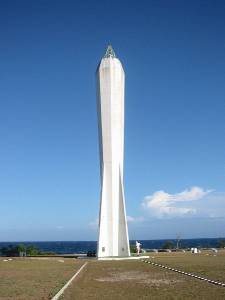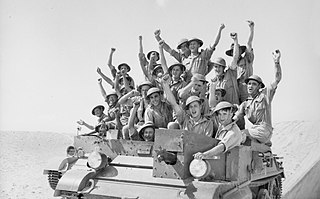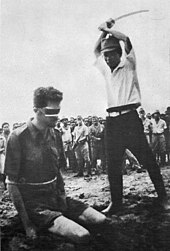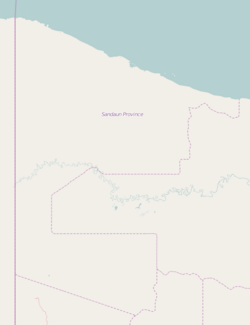
Sandaun Province is the northwesternmost mainland province of Papua New Guinea. It covers an area of 35,920 km2 and has a population of 248,411. The capital is Vanimo. In July 1998 the area surrounding the town Aitape was hit by an enormous tsunami caused by a Magnitude 7.0 earthquake which killed over 2,000 people. The five villages along the west coast of Vanimo towards the International Border are namely; Lido, Waromo, Yako, Musu and Wutung.

Wewak is the capital of the East Sepik province of Papua New Guinea. It is on the northern coast of the island of New Guinea. It is the largest town between Madang and Jayapura. It is the see city (seat) of the Roman Catholic Diocese of Wewak.
Kokoda is a station town in the Oro Province of Papua New Guinea. It is famous as the northern end of the Kokoda Track, site of the eponymous Kokoda Track campaign of World War II. In that campaign, it had strategic significance because it had the only airfield along the Track. In the decades preceding, it had been a foothills settlement near the gold fields.

Madang is the capital of Madang Province and is a town with a population of 27,420 on the north coast of Papua New Guinea. It was first settled by the Germans in the 19th century.
The Schouten languages are a linkage of Austronesian languages in northern Papua New Guinea. They are in contact with various North Papuan languages, particularly the Skou and some Torricelli languages.

The 2/7th Battalion was an infantry battalion of the Australian Army raised for service during World War II. Formed as part of the 6th Division shortly after the outbreak of the war as part of the all-volunteer Second Australian Imperial Force, the 2/7th Battalion's initial personnel were recruited primarily from the state of Victoria, although later reinforcements were drawn from most other Australian states. Basic training was completed in Australia, after which the battalion embarked for the Middle East as part of the first batch of Australian troops to deploy overseas. Further training was undertaken in Palestine before the battalion went into action against the Italians in January 1941. After participating in the successful capture of Bardia and Tobruk, it was committed to the disastrous Battles of Greece and Crete, where the battalion was essentially destroyed after the majority of its personnel were captured.

The Battle of Driniumor River, also known as the Battle of Aitape, 10 July – 25 August 1944, was part of the Western New Guinea campaign of World War II. During the fighting, Japanese forces launched several attacks on United States forces on the Driniumor River, near Aitape in New Guinea, over the course of several weeks with the intention of retaking Aitape. After making some initial gains, the Japanese attack was contained and eventually turned back having suffered heavy casualties. The battle should not be confused with Operation Persecution, which included amphibious landings near Aitape in April 1944, or the Aitape–Wewak campaign, which began in November that year.

The Western New Guinea campaign was a series of actions in the New Guinea campaign of World War II. Dutch East Indies KNIL, United States and Australian forces assaulted Japanese bases and positions in the northwest coastal areas of Netherlands New Guinea and adjoining parts of the Australian Territory of New Guinea. The campaign began with Operations Reckless and Persecution, which were amphibious landings by the U.S. I Corps at Hollandia and Aitape on 22 April 1944. Fighting in western New Guinea continued until the end of the war.

The Battle of Hollandia was an engagement between Allies of World War II and Japanese forces during World War II. The majority of the Allied force was provided by the United States, with the bulk of two United States Army infantry divisions being committed on the ground. Air and naval support consisted largely of U.S. assets, although Australia also provided air support during preliminary operations and a naval bombardment force.

The Landing at Aitape was a battle of the Western New Guinea campaign of World War II. American and Allied forces undertook an amphibious landing on 22 April 1944 at Aitape on northern coast of Papua New Guinea. The amphibious landing was undertaken simultaneously with the landings at Humboldt and Tanahmerah Bays to secure Hollandia to isolate the Japanese 18th Army at Wewak. Operations in the area to consolidate the landing continued until 4 May, although US and Japanese forces fought further actions in western New Guinea following a Japanese counter-offensive that lasted until early August 1944. Aitape was subsequently developed into an Allied base of operations and was used by Australian forces throughout late 1944 and into 1945 during the Aitape–Wewak campaign.
The 1998 Papua New Guinea earthquake occurred on July 17 with a moment magnitude of 7.0 and a maximum Mercalli intensity of VIII (Severe). The event occurred on a reverse fault near the north coast region of Papua New Guinea, 25 kilometers (16 mi) from the coast near Aitape, and caused a large undersea landslide which caused a tsunami that hit the coast, killing between at least 2,183 and 2,700 people and injuring thousands.

The Aitape–Wewak campaign was one of the final campaigns of the Pacific Theatre of World War II. Between November 1944 and the end of the war in August 1945, the Australian 6th Division, with air and naval support, fought the Imperial Japanese 18th Army in northern New Guinea. Considered a "mopping up" operation by the Australians, and although ultimately successful for them with the Japanese forces cleared from the coastal areas and driven inland, amidst difficult jungle conditions, casualties from combat and disease were high. With Japan on the verge of defeat, such casualties later led to the strategic necessity of the campaign being called into question.

The Sepik is the longest river on the island of New Guinea, and the second largest in Oceania by discharge volume after the Fly River. The majority of the river flows through the Papua New Guinea (PNG) provinces of Sandaun and East Sepik, with a small section flowing through the Indonesian province of Papua.
Tadji is a small town on the north coast of Papua New Guinea in Aitape Urban ward of East Aitape Rural LLG, Sandaun Province. Tadji is located to the east of Aitape. The town is home to Tadji Airport, which was built by the Japanese in 1942 during the World War II. The liberation of Tadji was the focus of Operation Persecution during April 1944, when the Allies captured the airstrip.
Operation Whiting was a military operation by Dutch and Australian forces during World War II in New Guinea by M Special Unit. It ran in conjunction with Operation Locust, and resulted in the capture and execution of Leonard Siffleet in October 1943, producing one of the most famous photographs of the war.
The Piore River or Lagoon languages form a branch of Skou languages. Historically most have been lumped together as a single Warapu language, with Nouri variously classified. They are spoken in the Sissano Lagoon area of West Aitape Rural LLG, Sandaun Province, Papua New Guinea. The Piore River runs to the west of all the languages, and so speakers do not find it an acceptable name. However, it is not clear which name would be better, as the name of the lagoon, 'Sissano', is used for different neighboring languages.
Aitape West Rural LLG is a local-level government (LLG) of Aitape in Sandaun Province, Papua New Guinea.

Sissano Lagoon is a lagoon located in West Aitape Rural LLG, Sandaun Province, Papua New Guinea.

On September 9, 2002, a magnitude 7.6 earthquake struck off the coast of Wewak, Sandaun Province, Papua New Guinea. The shallow reverse earthquake triggered a local tsunami measuring 5 meters high. The disaster resulted in at least 6 deaths, 70 injuries and building damage.

US Naval Base New Guinea was number of United States Navy bases on the island of New Guinea during World War II. Australia entered World War II on 3 September 1939, being a self-governing nation within the British Empire. The United States formally entered the war on 7 December 1941, following the attack on Pearl Harbor by the Empire of Japan. Following the attack on Pearl Harbor, Japan quickly took over much of the South Pacific Ocean. The United States lost key naval bases in the South Pacific, including Naval Base Manila and Naval Base Subic Bay, both lost in the 1941–42 invasion of the Philippines. Also lost were Naval Base Guam and Wake Atoll. As such, the United States Armed Forces needed new bases in the South West Pacific for staging attacks on Japan's southern empire. The United States built bases first in Australia, then in New Guinea.















